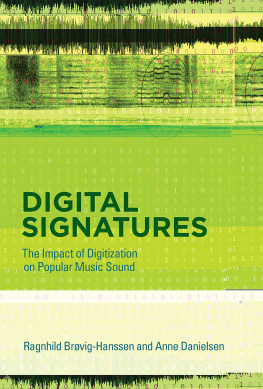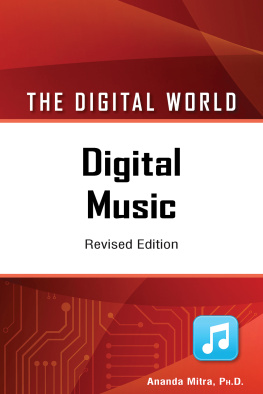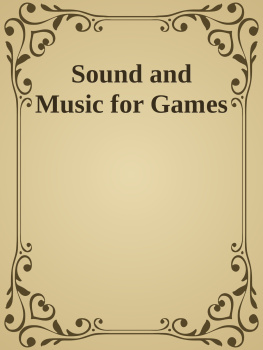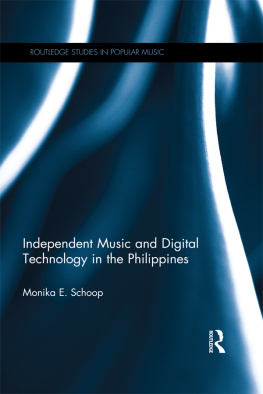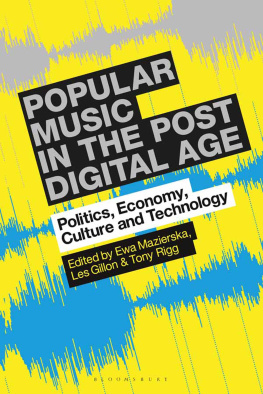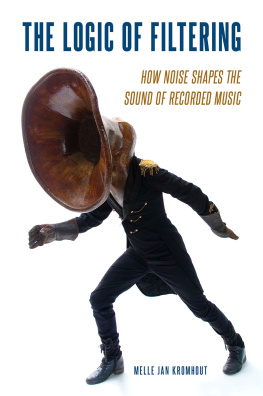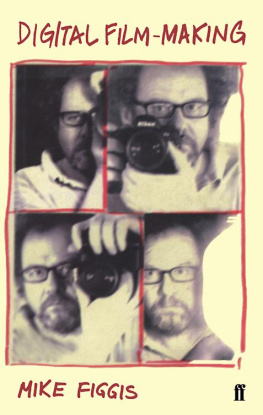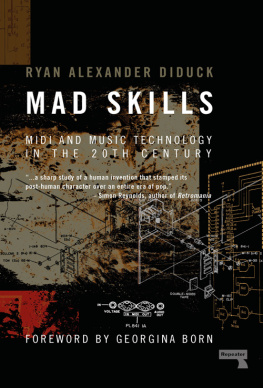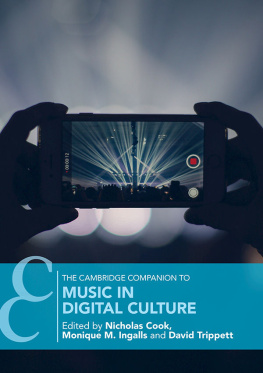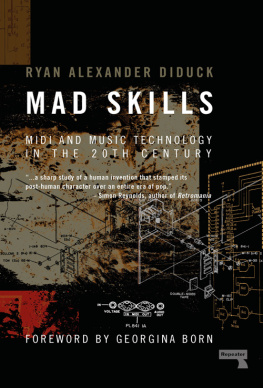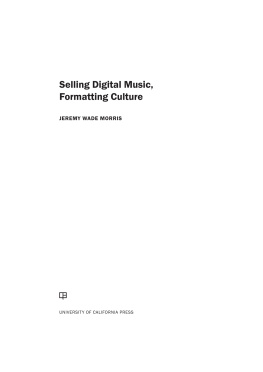Digital Signatures
Digital Signatures
The Impact of Digitization on Popular Music Sound
Ragnhild Brvig-Hanssen and Anne Danielsen
The MIT Press
Cambridge, Massachusetts
London, England
2016 Massachusetts Institute of Technology
All rights reserved. No part of this book may be reproduced in any form by any electronic or mechanical means (including photocopying, recording, or information storage and retrieval) without permission in writing from the publisher.
Library of Congress Cataloging-in-Publication Data
Names: Brvig-Hanssen, Ragnhild. | Danielsen, Anne.
Title: Digital signatures : the impact of digitization on popular music sound
/ Ragnhild Brvig-Hanssen and Anne Danielsen.
Description: Cambridge, MA : The MIT Press, 2016. | Includes bibliographical references and index.
Identifiers: LCCN 2015038376 | ISBN 9780262034142 (hardcover : alk. paper)
Subjects: LCSH: Popular musicPhilosophy and aesthetics. | Popular musicProduction and direction. | SoundRecording and reproducingDigital techniques.
Classification: LCC ML3877 .B77 2016 | DDC 781.640285dc23 LC record available at http://lccn.loc.gov/2015038376
EPUB Version 1.0
Contents
Preface and Acknowledgments
Music is always immersed in technology. Both authors of this book, for a very long time, have been fascinated by the various musical manifestations of this fact. The presence and mediation of musical technology are sometimes concealed by the music itself, and/or by its discourse, and at other times exposed, even to the degree that the musical technology occupies the listeners focus of attention. In either case, technology contributes significantly to the musical expression. Through a close reading of examples from the evolving practice of digital music production over the last thirty or forty years, we aim to illuminate the ways in which the newly developed techniques of digital sound technology have enabled a transformation of popular music sound. The book is addressed to a crossover audience of scholars and students across a range of academic disciplines (including popular music studies, music technology and record production, sound studies, and media and cultural studies), to media professionals and music practitioners, and to the general nonspecialist audience. We hope that this book will not only contribute to scholarship and research in the field but also encourage more of it.
This book started as an outgrowth of Ragnhild Brvig-Hanssens PhD thesis, Music in Bits and Bits of Music: Signatures of Digital Mediation in Popular Music Recordings (2013), for which Anne Danielsen served as supervisor. Throughout the thesis-writing process, we had many fruitful discussions related to our common interest in the various ways in which technology contributes to sound, and thus to our musical experience in general, and the impact of digitization on popular music sound in particular. After the completion and acceptance of the thesis, we both saw a need to extend the material and widen its potential outreach. Three seminal chapters from Brvig-Hanssens thesis (chapters 2, 4, and 5 in the present volume) were revised and complemented by three chapters written by Anne Danielsen (chapters 3, 6, and 7). Newly revised introduction and conclusion chapters were provided by Brvig-Hanssen, aided and supplemented by Danielsen, and then the entire contents and direction of the manuscript were adjusted, rewritten, and molded into the present book.
Many individuals made our work both possible and pleasurable. First and foremost, we wish to thank Douglas Sery of the MIT Press for his initial belief in this book and continually positive approach. We also want to thank the presss anonymous reviewers for providing valuable feedback. We are very grateful to Nils Nadeau, who copyedited the manuscript; in addition to his thorough and well-considered enhancement of its prose, he offered clever and constructive queries that enabled us to improve its content considerably. Our thanks also go to Hildegunn Lauve Hansen and Peter Knudsen for designing and helping with the illustrations. We found much inspiration at several Art of Record Production (ARP) conferences and want to thank the audiences of those conferences for their feedback on our papers, and for presenting inspiring papers in turn. We also want to thank the ARP conference organizers, Katia Isakoff and Simon Zagorski-Thomas, as well as the ASARP association for their important initiatives in supporting, encouraging, and networking the emerging field of the study of record production. Finally, we are very grateful to all of our colleagues at the Department of Musicology at the University of Oslo, in both the academic and the administrative staff, for the pleasure of their company, for the many interesting and inspiring (academic and nonacademic) discussions, and for their help and valuable insight. We also want to thank our students, from whom we have learned much.
In addition, Ragnhild Brvig-Hanssen wants to thank the Faculty of Humanities for providing her with the financial support to embark on the stimulating three-year journey that produced the PhD thesis upon which this book is based. In addition to Anne Danielsen, she is very grateful to Simon Frith, Bernard Gendron, Lydia Goehr, Stan Hawkins, Hedda Hgsen-Hallesby, Tellef Kvifte, and Susan McClary for their sharp-eyed readings and valuable feedback on early drafts of the initial thesis. She would also like to thank the appointed committee members of the PhD thesisNicola Dibbon, Stan Hawkins, and Albin Zakfor their constructive and detailed feedback, which proved to be particularly useful in the further elaboration of that manuscript into the present book. Finally, she wants to express her profound appreciation to her family and friends for their steadfast and unflagging support. Very special thanks go to her husband, Henning, and to her two daughters, Hedvig and Agnes.
Anne Danielsen is very grateful to Gisela Attinger, Gary Bromham, Richard J. Burgess, Erling Guldbrandsen, Stan Hawkins, Jrgen Langdalen, Preben von der Lippe, and Tellef grim for their valuable comments on different parts of the manuscript. She also wants to thank Christer Falck and Petter Aagaard for stimulating discussions about Princes music, and Mari Paus for her contribution to the initial phase of background research for chapters 3, 6, and 7. She also thanks her family, above all, for their patience and encouragement.
RBH and AD
Oslo, April 2015
Introduction: Digital Technology and Popular Music Sound
Throughout popular musics history, technological mediation has been imperative to its production, as well as its distribution and consumption. New developments in technology have always had an immediate impact on the art form, and digital technology is, of course, no exception. Obviously, the development of affordable computer-based digital audio workstations (DAWs)a software recording workstation running on computers with the possibility of audio and MIDI interface hardwaretogether with the development of the Internet, has had consequences for where, when, and by whom music is made, as well as how it is distributed and acquired. Consequently, the control and power of the professionals and their studio structures have been decentralized by an amorphous figure whom Paul Thberge labels the singer-songwriter-producer-engineer-musician-sound designer (Thberge 1997, 221222). The stereotypical narrative of the digital age of music and recording practices is that the amateur bedroom producer downloads preexisting music from the Internet via a peer-to-peer network, deconstructs and remixes the music on her or his laptop, and distributes and promotes the new version through Internet file-sharing sites from which fans download it, escaping industry control and undermining copyright laws. Equally important, however, are the ways in which this development has affected how the music

